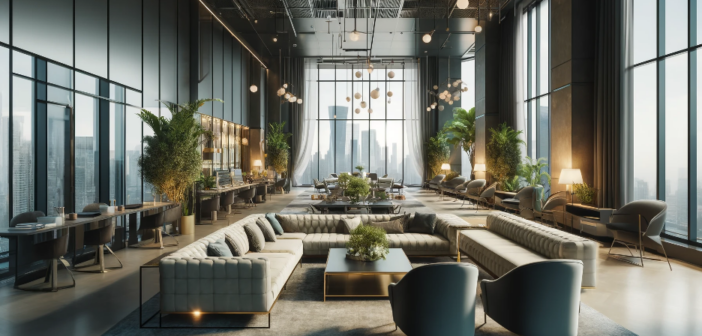As businesses grapple with a post-COVID world, Greycoat Real Estate CEO Nick Millican has a plan to create appealing new work spaces. lure employees back to the office.
The world is slowly finding its equilibrium after years of COVID-19 chaos, with many businesses issuing return-to-office mandates. The intention is to foster a tight-knit corporate culture and collaboration, but employees aren’t so sure about the switch. In fact, a report from Workplace Insight found that 35% of U.K. employees resent returning to in-person employment, believing it comes from “productivity paranoia” more than a need for culture-building.
Nick Millican, CEO of real estate development company Greycoat, disagrees. “It’s very, very difficult to build any sort of a team culture remotely. If you’re a business that recruits graduates, then you just can’t train them remotely,” he explains.
While he believes in-person work has a time and place, Millican doesn’t enjoy being in the office full time, either — especially if he has to work in a dreary building without amenities. “I personally don’t like going into the office five days a week, but I’m willing to go in a couple days a week if the place is nice and I’m working with the people I need to work with,” he says. “There has to be a professionally compelling reason to want to uproot.”
In an effort to balance employers’ need for face-to-face collaboration and employees’ desire for better workplaces, Greycoat designed its latest building, Suffolk St. James’s, with luxury amenities designed to support connection.
Real Estate’s Impact on Employee Well-Being
A building’s environment can have a tremendous impact on employee morale, productivity, and collaboration. In the past, Greycoat’s Millican found that executives treated employees like sardines, packing them into small spaces to cut costs. “Pro real estate goes through cycles. A lot of mainstream corporates viewed it as a cost center, where it was their real estate team’s job to lower the cost per desk and drive efficiency. You ended up with people being crammed into very dense open plans,” he says.
Offering perks like free pizza and T-shirts might feel like a smart way to resolve the issues caused by tight, depressing spaces, but Millican believes this can’t work over the long term. “It seems like offering people free lunch or a happy hour on Thursdays is not going to cut it anymore getting people to go into the office,” he notes.
Recent research supports this.
According to Corporate Wellness Magazine, on-site amenities help build culture. Instead of viewing amenities as nice-to-have extras, embracing these add-ons leads to big gains in employee satisfaction and performance. Amenities wow staffers and make them say, “This was worth coming in for.” The right amenities, like an on-site gym or child care, support work-life integration and can help attract top talent to an organization. Overall, boutique spaces lead to better morale, well-being, productivity, work-life balance, and a more positive corporate culture.
Boutique office spaces also light up the brain’s reward centers, helping employees feel acknowledged and taken care of in the new space. According to the Seisense Journal of Management, tangible rewards like free meals, child care, or an on-site gym affect employee job performance. The study found that rewards balance out stress, which has a negative impact on performance. Removing the stress by way of offering more perks has a significant impact on work quality and business performance. In other words, a business’s choice of office space can have just as much of an effect on productivity as management training and even compensation.
Employees expect better spaces if they give up remote work to come into the office. Boutique work spaces like Suffolk St. James’s, completed in 20232021, deliver on these expectations with a human-first approach to design.
Greycoat Real Estate’s Three Most Recommended Office Amenities
COVID-19 changed the trajectory for so many businesses, including Greycoat. “In the U.K., there was a very hard lockdown from March 2020 to July 2020. We had a period of time they would raise or lower controls. That was a very, very challenging time to run any business, especially a business where your focus whole thing is on offices where people are not legally allowed to work in,” Nick Millican recalls.
However, he doesn’t believe we should return to business as usual. As companies roll out return-to-office plans, Millican knows something must change. “I don’t think we have to get back to exactly the way things were in 2019. It has made people say, ‘Look, if we are going to drag our staff 45 minutes away from their house to come to work in the same place, then we have to do a better job of making that place somewhere they’d actually like to be.’ Make it a compelling reason to be there,” he advises.
That’s why the Suffolk St. James’s team worked diligently to create a beautiful, luxurious space employees love returning to. Millican details some of his favourite office amenities and how they affect tenants in the space.
Health and Well-Being
Nobody wants to be chained to a dreary desk for nine hours a day. The more access employees have to fresh air and opportunities to move, the happier and more alert they are during the workday.
That’s why Suffolk St. James’s includes four terraces, providing easy access to the outdoors even in an urban area. There’s one communal rooftop terrace, as well as private terraces on Levels 1, 2, and 3.
Building tenants have access to a studio gym and workout space, making it a cinch to get in a quick workout before or after the workday. Suffolk St. James’s also includes end-of-trip facilities with showers, lockers, and secure bicycle storage.
Opportunities for Connection
Meeting in person is a tremendous opportunity for building culture. To support more one-on-one connections, Millican’s team designed Suffolk St. James’s to include a fully equipped kitchen for catering and meetings, communal gathering areas, and shared meeting rooms on the ground floor.
Accessible, Sustainable Design
Employees with disabilities often face even more obstacles when returning to the office. That’s why inclusive design is the new standard. Suffolk St. James’s includes step-free access to all areas of the building and elevators.
The design team also paid close attention to sustainability. More and more employees care about their impact on the environment, and specifically the impact of their time at the office. “There’s increasing regulatory pressure to ensure that buildings consume less energy,” Nick Millican adds. That’s why Greycoat built Suffolk St. James’s following the principles of net-zero carbon design. The building also uses less energy and is currently working toward an EPC energy performance certificate “A” rating and a BREEAM building research establishment environmental assessment method “Excellent” rating.
Suffolk St. James’s: Where Luxury Meets Productivity
The corporate world is still grappling with the demands of the aftermath of COVID-19. While some businesses want a total return to the office, Greycoat CEO Nick Millican emphasizes balancing in-person collaboration with employees’ evolving expectations. While this project won’t solve cultural workplace challenges, Suffolk St. James’s luxury amenities show the power of real estate and the built environment on employee satisfaction and productivity. The shift toward boutique office spaces like Suffolk St. James’s heralds a new era where the quality of the work environment is as crucial as the work itself. In the near future, Millican hopes better design will make going to the office not just a necessity, but an enjoyable experience.




